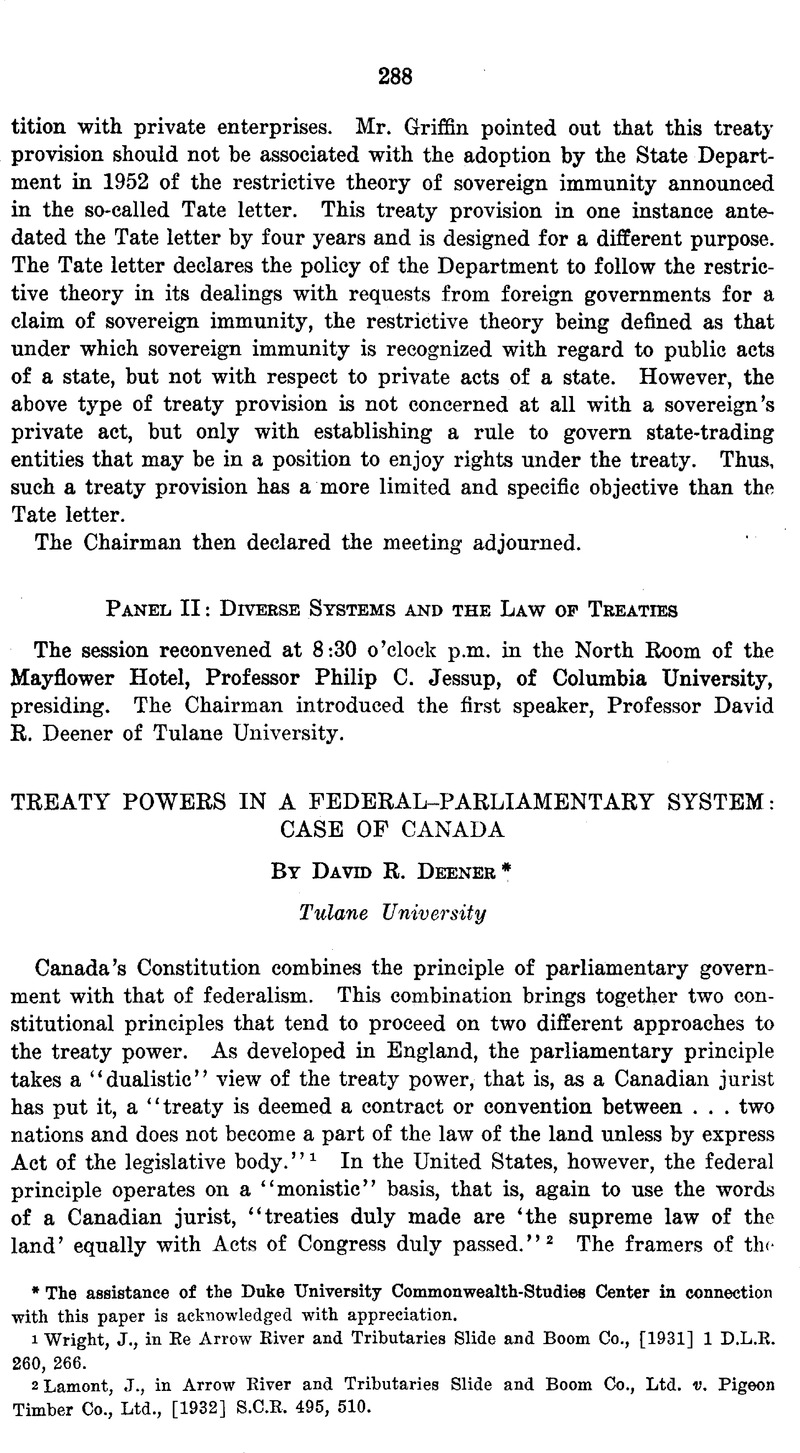No CrossRef data available.
Published online by Cambridge University Press: 27 February 2017

1 Wright, J., in Be Arrow Eiver and Tributaries Slide and Boom Co., [1931] 1 D.L.B. 260, 266.
2 Lamont, J., in Arrow Eiver and Tributaries Slide and Boom Co., Ltd. v. Pigeon Timber Co., Ltd., [1932] S.C.E, 495, 510.
3 Memorandum of July 21, 1952, from the Government of Canada, in Laws and Practices concerning the Conclusion of Treaties 24 (1953), U.N. Doc. ST/LEG/SER.B/3, December, 1952.
4 Cmd. 1987, 13. Stewart, Treaty Eelations of the British Commonwealth of Nations 75 (1939), points out that the Imperial Conference Was simply “sanctioning the precedent” established in the Halibut Fisheries Convention of 1923 with the United States. This convention had been negotiated between Ottawa and Washington, and signed by representatives of Canada and the United States, to the exclusion of a representative of the British Government.
5 [1932] A.C. 304, 312.
6 [1937] 1 D.L.B. 673, 680.
7 Ibid. 681–682.
8 Ibid. 683–684.
9 Hendry, Treaties and Federal Constitutions 33 (1955).
10 [1936] S.C.B. 461; the Court had divided 3 to 3.
11 [1925] S.C.B. 505, 512.
12 See Soward, “External Affairs and Canadian Federalism,” in Lower, Scott et al., Evolving Canadian Federalism 133–134 (1958).
13 Szablowski, “Creation and Implementation of Treaties in Canada,” 34 Canadian Bar Review 59 (1956).
14 Cohen, “Some International Law Problems of Interest to Canadian Lawyers,” 33 Canadian Bar Eeview 396 (1936).
15 Rainy Lake Eiver Boom Corp. v. Rainy River Lumber Co., [1912] 6 D.L.R. 401.
16 Arrow River and Tributaries Slide and Boom Co., Ltd. v. Pigeon Timber Co., Ltd., [1932] S.C.R. 495.
17 See Martin, “The Diversion of Columbia River Waters,” 1957 Proceedings, American Society of International Law 2–8.
18 Cohen, “Some Legal and Policy Aspects of the Columbia River Dispute,” 36 Canadian Bar Review 37–38 (1958).
19 See Memorandum of July 21, 1952, from the Government of Canada, cited at note 3 above, where it is stated that it is “difficult for Canada to enter into some international conventions such as the proposed Covenants on Human Rights and Fundamental Freedoms without the inclusion of a federal state clause.” Consultation with the Provinces prior to entering into agreements of the kind in question may be had.
20 The British North America Act, 1940, 3–4 George VI, c. 36.
21 The British North America Act, 1951, 14–15 George VI, c. 32.
22 See especially Johanneson v. Eural Municipality of St. Paul, [1952] S.C.R. 292, with respect to aeronautics. The principal sections of the British North America Act, 1867, dealing with the division of powers between center and Provinces are 91 and 92. Sec. 92 (13) assigns “Property and Civil Rights in the Province” to the class of exclusive Provincial powers.
23 Under Sec. 92 (10c) of the British North America Act, 1867.
24 Revised Statutes of Canada, 1952, c. 11.
25 Pronto Uranium Mines Ltd. v. Ontario Labour Relations Board, [1956] 5 D.L.R. (2d) 342.
26 Preuss, “Enforcement of Treaty Obligations through International Law—System of the United States and of Some Other Countries,” 1951 Proceedings, American Society of International Law 82–100.
27 See Evans, “Some Aspects of the Problem of Self-Executing Treaties in Municipal Law,” ibid. 66–75.